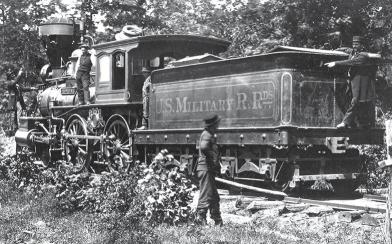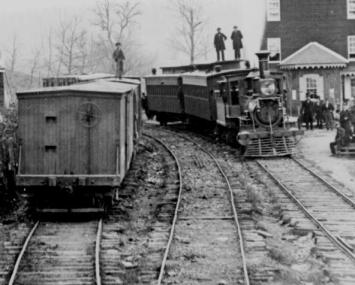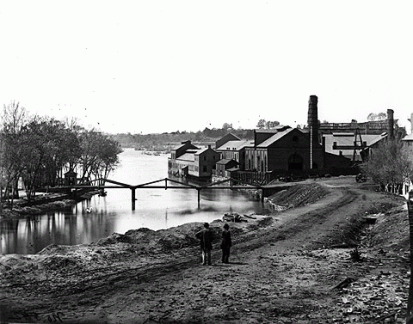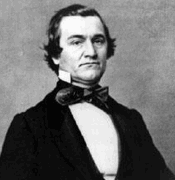Posts Tagged ‘union’
“Texas Jack” Omohundro Round Up
I’m vacationing this week in Forth Worth, Texas attending the “Texas Jack Round Up,” the bi-annual gathering of the “Texas Jack” Association (see website here). John B. “Texas Jack” Omohundro was enormously famous in his era. The best friend of William “Buffalo Bill” Cody, he was a famous western scout. And, he’s family, that is to say I married into the extended family.

John B. “Texas Jack” Omohundro
Source: http://www.Texasjack.org
The following is a quick snapshot of Jack’s Civil War experience.
When the war between the states broke out, Jack’s older brother Orville (pictured with Jack below) joined the Confederate army as a lieutenant under the command of Col. J.E.B Stuart. Jack, then 14, immediately volunteered his services, and was, to his great disappointment, denied because of his age. After several attempts, he was finally accepted into the army when he was l6, and was assigned to his brother’s regiment.

John B. (left) and Orville Omohundro
Source: http://texasjack.org
Jack immediately gained renown as a scout of ability and bravery, working directly under Col. Stuart (pictured below), and was soon to be widely known as the “Boy Scout of the Confederacy”. Many times, he would act as a spy, moving among the Union troops as a chicken peddler or some other kind of tradesman, obtaining information about the enemy. Little was he to know that within the next 10 years, his best friends and saddle-mates would be former Union soldiers.
Colonel J.E.B. Stuart, CSA
Sources: Wikicommons
On the Civil War’s Last Veterans, Wives, and Stats
While in search of documentation for Civil War statistics, I discover the Fact Sheet: American Wars published in November 0f 2007 by the United States Department of Veterans Affairs. It provides the following:
It lists the last Union veteran as Albert Woolson (right) who died August 2 1956 at age 109. He was a member of Company C of the First Minnesota Heavy Artillery Regiment but never saw action. A brief biography is available here.
The last Confederate Veteran, John Salling, died March 16, 1958, at age 112. Some references, including one available here, suggests that he may have been an imposter.
And the last Union widow, Gertrude Janeway, died January 17, 2003, age 93. Mrs. Janeway death was covered in the January 21, 2003 issue of New York Times here. In brief, she was married to Union veteran John Janeway at age 16. He was 81. They made their home in a three room log cabin in Blaine, Tennessee. He died there at age 91 in 1937. She died in the same home. Mr. Janeway fought for the 11th Illinois Calvary under the name January. A photo of Mr. and Mrs. Janeway shortly after their wedding and of Mrs. Janeway in 1998 available here.
The last Confederate widow was Mrs. Alberta S. (Stewart) Martin who died in May 31, 2004. A site dedicated to Mrs. Martin including photos is available here. She was married to veteran Willaim Jasper Martin when she was 21 and he was 81.
A transcript of a 1998 interview with Mrs. Martin is available on radiodiaries.org here. Host Robert Siegel also interviews Daisy (Graham) Anderson who was, at the time, also one of the last know Union widows. Mrs. Anderson was married in 1922 at age 21 to Robert Anderson, then age 79, who was an escaped slave who joined the Union Army and served in the 125th Colored Infantry near the war’s end and in the Indian campaigns. He was a successful homesteader in Nebraska. Their story is available in the New York Times article about her death here. A article about Mr. Anderson’s fascinating life, titled “The Odyssey of an Ex-Slave: Robert Ball Anderson’s Pursuit of the American Dream,” by Darold D. Waxm is available through JSTOR here.
Civil War (1861-1865)
Total U.S. Servicemembers (Union)…………..2,213,363
Battle Deaths (Union)………………………………140,414
Other Deaths (In Theater) (Union)………………..224,097
Non-mortal Woundings (Union)…………………..281,881
Total Servicemembers (Conf.) (note 2) ………..1,050,000
Battle Deaths (Confederate) (note 3) ………………74,524
Other Deaths (In Theater) (Confed.) (note 3, 4)……59,297
Non-mortal Woundings (Confed.) ……………..Unknown
2. Exact number is unknown. Posted figure is median of estimated
range from 600,000 – 1,500,000.
3. Death figures are based on incomplete returns.
4. Does not include 26,000 to 31,000 who died in Union prisons.
Were the North and South Evenly Matched…on the Rails?
One of the questions that was much debated in class was whether the North and South were evenly matched in the American Civil War? To get the discussion rolling, our professor threw out the following…
In his interesting study of the American Civil War, Archer Jones argues in Civil War Command and Strategy: The Process of Victory and Defeat (1992), that despite its superior numbers, the Union advantage was greatly diminished by the extent of Southern territory, the intrinsic superiority of the defense over the offense, and the problems of supplying armies over long distances. Jones also states that Northern industrial dominance also proved almost useless in a war that depended less on complex weaponry and ammunition than on the man with the rifle. In Jones’ opinion, the two sides were, in fact, almost evenly matched.[i]
Our task was to take a stand on whether the North and South were evenly matched. I decided to focus on the very specific area of railroad transportation during the war. Part of my interest in this area comes from my association with friend and rail historian Peter A. Hansen, the editor of Railroad History and author of a number of articles for Trains Magazine. I was able to interview him on the topic and have included a good part of that in the post below. The photo below will be included in the upcoming issue of Railroad History which “is given over to a nearly-encyclopedic overview of every company that ever built steam locomotives in America.”[ii] The principal contributor is John H. White, Jr., former curator of transportation at the Smithsonian Institution.
Photo: New Jersey Locomotive & Machine-built 4-4-0 Fred Leach near Union Mills, Va., on August 1, 1863, the year after it was built. Its stack and tender have taken cannon shot, and the main rod is missing. It became Orange and Alexandria Warrenton after the American Civil War. Library of Congress: 111-B-185.

Charles Roland, in his book An American Illiad: The Story of the Civil War, provides a strong case for the American Civil War being considered the “first complete railroad war.” He asserted that the North was well ahead of the South in railroad resources entering into the war with 20,000 miles of rails in 1860 to the South’s 10,000. The railroads of the north were better “linked into systems of trunk lines that covered the entire region.”[iii] There were other things that made the North’s railroads superior. “First, it was dotted with locomotive factories, concentrated particularly in Massachusetts, Paterson, New Jersey, and Philadelphia. All of them remained beyond the reach of Rebel forces, so production was never disrupted. It was never disrupted for want of materials, either, since most of the iron ore and coal were also concentrated in the North.”[iv]
“In addition, the North’s railroads were almost all built to the standard track gauge of 4’ 8 ½”. That meant the cars could be interchanged from one line to another without the need for time-consuming unloading and reloading of passengers and freight. In the South, the rail network was pretty thin to begin with, and the multiplicity of track gauges hampered operations even more. That was particularly important considering that most of the war was fought on Southern soil. With the notable exception of one shining moment at the First Battle of Bull Run, the South was never consistently able to rush men and materiel to the front by rail. There were just too many obstacles to such smooth operation in most of Dixie.”[v]
Photo above: Station at Hanover Junction, Pa., showing an engine and cars. In November 1863 Lincoln had to change trains at this point to dedicate the Gettysburg Battlefield. LOC: 111-B- 83.
Photo below: The four-tiered, 780-foot-long railroad trestle bridge built by Federal engineers at Whiteside, Tenn., 1864. A guard camp is also shown. Photographed by George N. Barnard. LOC: 111-B-482.
“It’s a little-known fact, but track gauge was the first big standardization issue – in any industry. It seems incredible to us from our modern perspective, but many people were slow to grasp the need for standardization. It had never been needed in the days when every village had its own blacksmith or carpenter, whose products never needed to be used in conjunction with those of the smithy or carpenter in the next town.”[vi]
Photo above: Tredegar Iron Works. Artist: Alexander Gardener, Public Domain, Wikipedia Commons.
“The South didn’t have a single locomotive factory of any consequence during the Civil War. Several had made a start during the 1840s and 1850s but failed to survive into the War years – including Richmond’s famous Tredegar Iron Works (see the American Civil War Center’s site at Tredegar Iron Works here). While the firm itself survived until 1956, they produced locomotives only from 1851 to 1860. Even as the storm clouds were gathering, they decided in late 1860 that the locomotive business wasn’t profitable for them, and they retooled the shop for other uses.
“[vii]
Photo right (cropped): James Noble Sr. from www.civilwarartillery.com/manufacturers.htm.
“Aside from Tredegar, the only wartime Southern locomotive factory that’s even marginally worth mentioning was James Noble and Son of Rome, Georgia. They produced only a few locomotives after 1855 and their factory was destroyed by Sherman’s army in 1864. What this means, of course, is that Southern railroads became increasingly dysfunctional as their locomotives were destroyed, since they had no means of replacing them. It also meant that their remaining locomotives were often old, and/or held together by any means possible.”[viii]
McPherson substantiates this in his book, Battle Cry of Freedom. He indicates that of the 470 locomotives built in the U.S. in 1860; only 19 were built in the South.[ix] According to Hansen, “the production of 470 locomotives in a single year may seem like a large number. But it is less surprising in light of two things. First, railroad mileage in the U.S. had surpassed 30,000, and about 2/3 of that total had been built in the previous decade. Just like new highways today, there was comparatively little traffic on new lines in their first couple of years, but usage mushroomed when people and businesses began to change their previous transportation preferences, and when businesses began to locate along the new lines. When a line began to see more traffic, whether two or five or eight years after it was built, new locomotives were needed to handle it. An economist might say that the need for rolling stock lagged the actual construction by a few years.”[x]
“Another thing to consider is the poor utilization of assets in those days. Just as standardization was a new concept in the middle of the 19th century, so, too, was asset utilization. The latter concept is quite recent indeed, not being fully understood until just the past decade or so. [Note: Consider that Southwest Airlines ran circles around its competitors for years, chiefly because SWA insisted on having an entire fleet of identical planes, and on keeping them on the ground for only 30 minutes at each stop. The underlying rationale for both policies was better asset utilization. The older airlines are still struggling to apply those same lessons.] A steam engine is a highly labor-intensive beast. It requires constant attention from fireman and engineer alike in order to get maximum productivity while it’s working, and it spends about two hours in the shop for every hour it spends on the road. That time is absolutely necessary to the proper functioning of the machine, since grates need to be shaken, ashes need to be dumped, and moving parts need lubrication. (Tallow was a common valve lubricant in those days before petroleum engineering, and applications had to be repeated frequently.) About once a month, the steam engine’s fire was dumped altogether so the tubes and flues could be inspected. The process of cooling an engine down, inspecting it, and firing it back up typically took 24-48 hours, so there’s a big chunk of unproductive time right there. So the bottom line is that they needed a lot of locomotives in those days!”[xi]

Brilliant Uses of Railroads
The South did have some success with the use of trains for troop transfer. Johnston’s use of the Manassas Gap Railroad to move his troops to Manassas Junction to reinforce Beauregard was brilliant and no doubt influenced the outcome of that engagement which so demoralized the North. Roland also reviews Bragg’s “almost incredible strategic use of the railroads” against Buell as the latter approached Chattanooga. “The Confederates half-circled the Union army by moving 30,000 from Tupelo, Mississippi, roundabout by way of Mobile and Atlanta to Chattanooga, a movement of some 776 miles.”[xii] Hansen felt that, “while it was true that Bragg’s campaign was a remarkable success in the face of daunting logistics, this was the exception that proves the rule.” The mere fact that he had to detour 776 miles in order to go 300 speaks to the paucity of railroads in the South. And even in his 776-mile detour, he had to port his troops on foot east of Montgomery, where the railroad ended, before he could load them on trains again near Columbus, Georgia. So yes, the railroads helped him win, but I submit that it was his audacity, combined with Buell’s dithering, that gave him the ability to make the best of a questionable asset.”[xiii]
Hansen added, that “it is worth noting that railroads were the whole reason Chattanooga had such strategic significance. The principal line from Richmond to Atlanta, and the line from Memphis to the east, converged there. Without Chattanooga, the South’s ability to move men and materiel by rail in their own territory was all but gone.”[xiv]
Thomas Ziek, Jr. came to the same general conclusion in his Master’s Thesis, “The Effects of Southern Railroads on Interior Lines during the Civil War.” He tried to determine whether or not the South enjoyed the advantage of interior lines and concluded that they did not.
The use of railroads during this conflict placed an enormous physical strain upon the limited industrial resources of the Confederacy, and a great strain upon the intellectual agility of the Confederate High Command. Based upon the evidence studied, and the time-space comparisons of both Northern and Southern railway operations, several conclusions can be drawn: the South entered the war with a rail system that was unable to meet the demands of modern war; the Confederate leadership understood the importance of the railroad and its importance to strategic operations early in the war, but were unwilling to adopt a course of action that best utilized their scarce assets; Union control, maintenance, and organization of its railway assets ensured that it would be able to move large numbers of troops at the strategic level efficiently from early 1863 to the end of the war. Based on these conclusions, the Confederacy lost the ability to shift troops on the strategic level more rapidly than the Union by 1863. This was a result of its physically weakened railroad system and military setbacks which caused Southern railroads to move forces over longer distances.[xv]
My conclusion, for this area of focus, is that the North and South were NOT equally matched either in their physical rail assets nor in their management of those assets. While the South had some moments of brilliance in their use of railroads, they simply did not have the infrastructure to maintain, let alone expand, the railroads of their region to their greatest advantage.
© 2007 L. Rene Tyree
[i] White, Charles, AMU CW500.
[ii, iv, v, vi, vii, viii, x, xi, xiii, xiv] Hansen, Peter A., Personal interview. Sept. 9, 2007
[iii, xii] Roland, Charles P. An American Iliad: The Story of the Civil War
[ix] McPherson, James M. Battle Cry of Freedom
[xv] Ziek, Thomas G., Jr., “The Effects of Southern Railroads on Interior Lines During the Civil War.” A Master’s Thesis.






 of schools and colleges taught “Southern Nationalism” and impressed on the minds of students the “standard ‘line’ on the issues of slavery, politics, and economics.”
of schools and colleges taught “Southern Nationalism” and impressed on the minds of students the “standard ‘line’ on the issues of slavery, politics, and economics.”
![[Charleston Harbor, S.C. Deck and officers of U.S.S. monitor Catskill; Lt. Comdr. Edward Barrett seated on the turret].](https://i0.wp.com/memory.loc.gov/service/pnp/cwpb/02900/02975r.jpg)















































